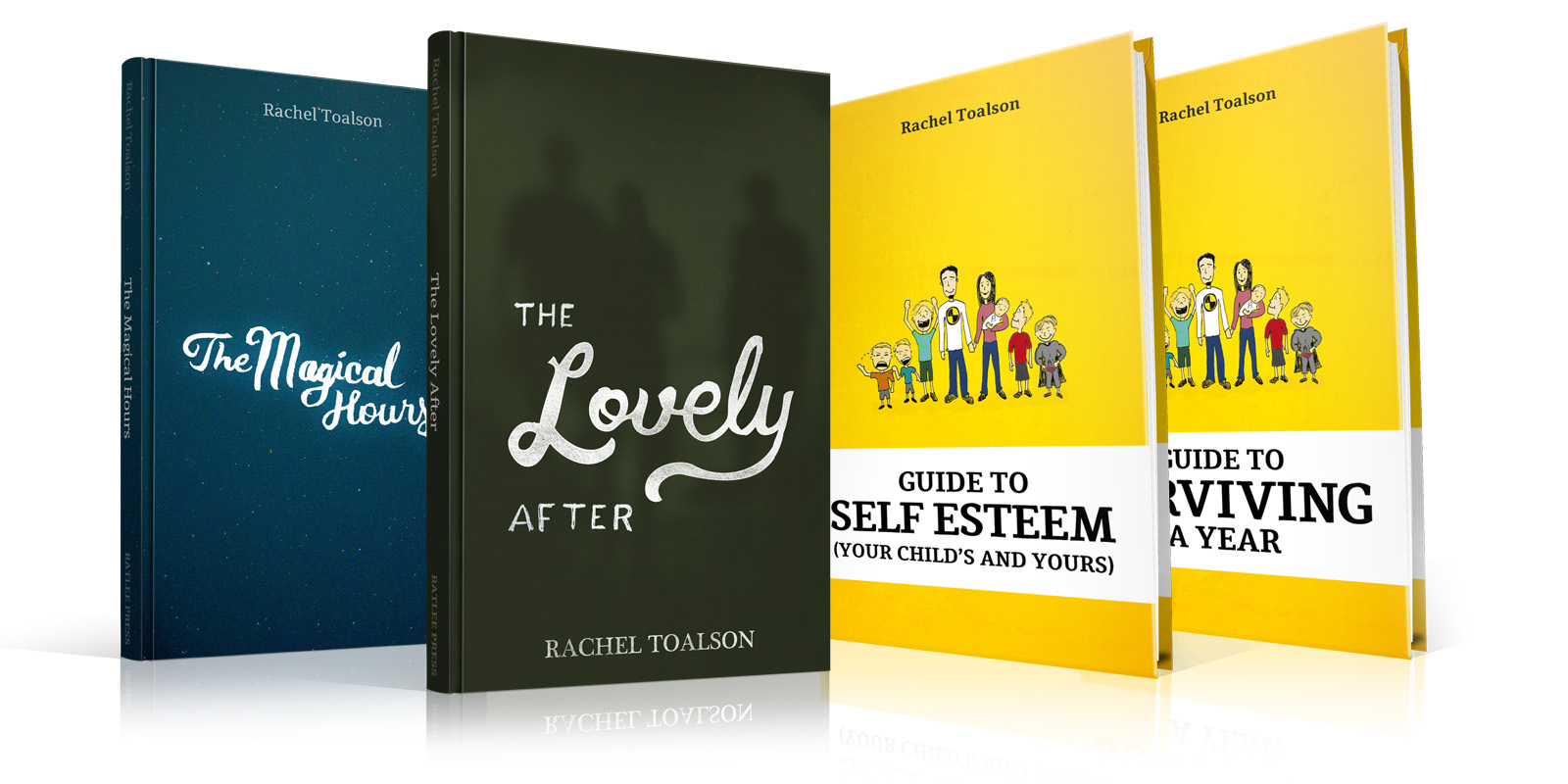
by Rachel Toalson | This Writer Life
Lately I’ve been having trouble finding balance.
I have heard it said that in order to be prolific at what we do, balance is not something we can achieve. But I don’t believe it. Or maybe that’s just not the kind of prolific I want. Balance is important in my life.
[Tweet “It’s not easy to find balance as a parent writer. But it’s possible.”]
As writer parents, it’s essential that we find balance in both our professional and personal lives.
Parenting can feel all-consuming, because those babies are precious, and they don’t stay little for long, and shouldn’t we be using the time we have to just enjoy everything about them?
And writing can feel all-consuming, because those stories come knocking, and it’s not easy to put down the pen once we get started, and writing isn’t always something we can do in bits and pieces and fits and starts, and shouldn’t we be using the time we have to create?
Balance can sometimes feel impossible when kids are sick or the epiphany we had while making breakfast flew right out of our heads while we were opening our notebook to write it down.
A couple of weeks ago, while my kids were playing with cars right in front of me, I was crafting pitches to send out to various publications. And right in the middle of my writing, that voice came creeping in.
Shouldn’t you be enjoying the last mornings you have with your boys?
My boys started school recently, and, before they did, I had been meaning to spend more quality time with them, because summer was a madhouse, and I didn’t get in as many quality time-with-boys hours as I wanted. At the same time, pitches have deadlines, and I knew I needed to do them now if I wanted the best chance for my manuscripts.
I feel this tension all the time—play with my kids or try to get more work done. Teach the 4-year-olds preschool, like I did all the other boys, or take a few minutes to myself and actually read something I enjoy—that’s not full of letter sounds and “which one is different” and colors and shapes.
There’s always so much work to do and so many new things to learn about in the life of a writer, and there is always so little time in which to create and still enjoy my children without deadlines hanging over me.
It’s possible to achieve balance, but it may look differently than we think it should. Sometimes the expectations we have for ourselves are the hardest expectations to achieve—and we have to take a step back to see why we’re expecting so much and whether we can let the pressure off a little. That’s the first place I always start.
[Tweet “The first place to start in attempting balance is with our expectations. Let the pressure off.”]
But here are some other places I’ve found ways to step toward balance in my writer-mom life:
1. Quit looking at the competition.
There are many writers out there cranking out stories at an impressive rate. Many of them are not parents. We should stop trying to be like them. We move at our own pace. Maybe we can’t write a book every 30 days or 60 days or 200 days. That’s okay. If we are doing the daily work of it, we will, eventually, have a book.
We have time restraints, and sometimes that can seem like it’s a handicap. But according to research, restraints can be good for us. They can make us more creative, if we use them to our advantage.
2. Invite the children in.
If you’re having trouble achieving balance, invite your children in to your work. My children know that, every morning at 6:30 a.m., we will listen to an audio book while we’re all getting ready to leave for school. They know that once a week, during Family Time, we will have a writing night—and sometimes that means collaborating on a story together and helping Mama work out a plot line where she’s stuck. Sometimes it means reading excerpts from writing books we’ll read together.
There is something sacred about that shared space.
3. Establish set hours.
Parents who work from home can have a tough time with balance if we have no set hours. My kids know that from 9-9:30 a.m. I am catching up on emails and business matters, but the rest of the morning, I am available to them. If I receive an email outside of those morning “office” hours, it can wait until later.
They know that during their naps and Quiet Time I will be working but am available for emergencies. They know that from 1 until 5 p.m. their daddy is on duty.
If I am doing any business outside of those hours, they will call me on it.
Sometimes, when a deadline is looming, it’s necessary to work on finishing a story during Family Movie Night, but open lines of communication are important for those instances when office hours creep into family hours. We don’t ever want our children to believe that our work is more important to us than they are. But we do want them to understand that our work is important.
4. Adjust your mindset.
Some days we just won’t get a whole lot of work done, because a boy was feeling sick or lonely or doubly mischievous. If we can shift our mindset from “I didn’t get everything done that I needed to get done today” to “Today’s work is enough for today,” we will be happier people, and so, by extension, will our children.
Balance and brilliance are not opposite poles. They can exist together. But it will take great intention and focus and compromise.
It’s a good thing we’ve already mastered that as parents.
Week’s prompt
A picture is one of my favorite ways to generate inspiration. Look at the picture below. Write whatever you want for as long as you can.
Photo by Ben Rosett.

by Rachel Toalson | This Writer Life
If you’re not around any of my social media channels, you might not know that after two years and more than 150 rejections on two different novels, I finally signed with an agent. I am incredibly excited and am currently working on revisions to my middle grade historical novel written in verse, which we’ll be sending out to potential publishers this month.
But I knew that I couldn’t share this news without also sharing my story. If you’re new here, you might not know that I’ve self published a few titles—but what my dream has always been, since I was a little girl, is to be a traditionally published author. So securing an agent was always in my plans.
After I wrote my first novel, which was an adult literary novel written in verse, I researched all the agents who might be open to receiving something like that. There were about 140. So I put them all on a list, and in a matter of months, I’d emailed them all with a query letter and, depending on what they asked for in their submissions process, a few pages of my novel. I had a few bites on it, but nothing really serious, so I turned my attention to my second novel, which was a middle grade historical novel written in verse.
For this one I executed a different strategy. I stalked places like the twitter hashtag #MSWL, where agents will post about certain types of books they’re looking for. I had a much more targeted list. I sent my story out to 13 agents. Six of them asked for the full manuscript—which is almost half.
What this tells me is that targeting your queries is a much more effective process than simply looking for what agents accept. Sure, they might accept literary novels, but they’re looking for a specific one.
[Tweet “Target your agent queries based on current submission calls. It’s much more effective.”]
I received my first offer from an agent about six months after all those full manuscripts went out. This allowed me to turn around and let other agents, who still had my full manuscript, know that I’d received an offer, so if they wanted to make an offer, they could. This resulted in another offer, some non responsiveness and a decline. So I had a choice on which agent I wanted to work with—which was probably the hardest thing I’ve ever had to do. But, in the end, I made it, and I signed with my agent.
Querying projects is a long and arduous process. We will be knocked down and picked up and knocked down again. My best advice? DON’T EVER GIVE UP. Even when your fragile self esteem can’t take another rejection. Even when you can’t possibly do this anymore because it’s too disappointing and hard. Even when you think you’re finished for good.
Keep learning, keep querying, keep improving and writing, and it will happen.
[Tweet “My best advice for securing an agent? NEVER GIVE UP.”]
My (other) best tips for securing an agent:
1. Do you research.
Make sure you’re sending your query to the right person. Make sure it’s something they would want to see. Make sure you’re not wasting your time or their time. Obsessively scour places like #MSWL on Twitter and the Manuscript Wish List blog. Find new agents looking for something that sounds similar to your own project. And don’t just look for agents who want “literary fiction.” Look for agents who want “literary fiction with a death at the center and a new definition of family in its pages,” if that’s the kind of book you have. You’ll waste a lot of time querying the generalizations. Go for the specific.
2. Pay attention to your rejections.
Sometimes agents will include a short note that might help you improve your manuscript so that the next agent you send it to won’t reject it so easily. Which is why it’s always better to send queries in waves instead of all at once. My first querying process was one large tsunami of queries. I sent them all within a week. The next querying process took place over six months—one agent one week, another the next week, and so on. Sometimes a couple of months passed between queries. I wanted to make sure I was learning from the feedback I received (and when you actually get some feedback, you know you’re almost there. So be heartened.).
3. Keep your ego in check.
Try not to let the rejections bother you. Writing is a very subjective process. We know this, as writers. We don’t all like the same books. Neither do agents. So try not to take a pass on your manuscript personally. You are more than your work.
And never, ever, ever diss an agent, no matter what kind of response you get. You’ll pretty much be blacklisted.
4. Never give up.
I’ve already mentioned this one already, but it really can’t be underestimated. If there’s anything you can learn from my story, it’s that you should never give up. If you have a solid book and you’re willing to work hard enough to secure representation, it’s going to happen. It may take a while. It may even take until the moment you’ve given up on it all. But with perseverance and dedication and willingness to learn and improve your craft (because we can ALWAYS improve, even if we think we’re the greatest writer ever (we’re not)), it will happen.
Week’s prompt
Write as much as you can, in whatever form you want, on the following word:
Team

by Rachel Toalson | This Writer Life
Kids are away for the weekend, and my husband and I are sitting in our bedroom, with the two whiteboards out, brainstorming what comes next in our creative endeavors.
He looks at my side, all those ideas I’ve listed noncommittally, and he says, That looks like a lot.
And I know what he’s saying. It looks like too much.
I can do it, I say. He shrugs a little and turns back to the boards. So I say, Some of those I don’t really have to do. They’re just ideas for now.
But the truth is, I want to do them all.
There is so much I want to do, so many stories and poems and pieces of my heart that want to be written. But there is only a limited amount of time, a limited amount of me.
I wish it weren’t so. I wish I could spend hours and hours every day creating and writing and brainstorming into being all the bare-bone ideas that come calling. I keep a journal full of these ideas, short stories and novels and nonfiction books that wait for writing, and that list doesn’t seem to be getting any shorter. I add to it every week.
How do we who are bursting with ideas find the discipline to take it one at a time?
There is no easy answer to this.
Because sometimes we will start on one project and find that we don’t have the time needed to make it good or lovely or interesting; or we find we don’t have the passion for it, at least right now; or we find we don’t have all the details worked out and need to let it sit for a while.
There is no shame in starting and then putting aside, as long as it doesn’t stay put aside.
Sometimes we move through seasons where we can work on multiple projects—crafting a book of poetry at the same time we’re writing a novel that’s waited years to see paper—and our creativity still feels alive and eager and magical. And sometimes we move through seasons when we can barely fit in the time to work on one project, even though more ideas are pelting us in the back when we turn away.
It’s not easy to remember that there is a time for everything.
[Tweet “There’s a time for everything. We may not be able to get to that creative project now–but we will.”]
I’m not so great, sometimes, at recognizing my circumstantial limits—because I love what I do and I just want to write and who cares if I’m working on ten projects all at the same time. It always seems like the right time to me.
But if we are pursuing an idea out of season, we are bearing fruit that is expensive and sour, fruit that steals valuable resources from other projects that might be entering the perfect season. So it’s not worth it to cram our schedule full of so many projects, because we can only tell our stories and write our whole hearts well if we’re doing it in the right season.
Sometimes it’s the right season for poetry. Sometimes it’s the season for that fantasy novel we’ve been setting aside for too long now. Sometimes it’s the season for 365 essays that turn into an unexpected book.
We must determine the season and then fit those projects in the right places, understanding that “not now” doesn’t mean “never.”
We do ourselves no favors trying to tackle too many projects and not giving any of them the time they really deserve. We do ourselves no favors trying to start a new project every time we think of one and rushing through the finish of the old one we honestly don’t have much interest in anymore now that this new idea has come along. There is discipline in the finishing, in the saying, “not right this minute” to the new projects breathing on our necks.
I take my time, because I know that, eventually, I will get to those other forty-five projects (as of today) on my brainstorm list.
[Tweet “Our creative projects deserve time. We can’t create well if we’re always rushing to the next thing.”]
And if I don’t, well, then, maybe they weren’t such great ideas after all.
How to Pace Yourself in the Writing Trenches:
1. Keep a brainstorm journal.
I carry a journal around everywhere I go. Every time I think of a new idea, I write it down. For novel ideas, I start a new page, and every time I have some sort of inspiration about the novel, I record it all on the page–so when I have time to actually sit down and brainstorm that particular novel, I’ll be prepared with all the thoughts that have come before. For short stories, I’ll typically jot down a potential title or a short sentence that details what the story will be about. For poems or essays, I usually write down the gist of what it will be about, so it can sit in my subconscious for a while.
Here’s another hack, if you’re like me: Index cards. I carry them around with me everywhere. I use these to jot down plot points of books I haven’t started writing yet. Sometimes I’ll be out watching a movie with my husband, and I’ll think of a scene for a book that’s on my “to-get-to” list. I’ll just jot down the scene and add it to the stack of notecards about that book. This helps me feel like I’m working on the book when I’m really just letting it slowly develop without any pressure.
2. Ask “What do I feel most passionate about right now?”
It’s not easy to get started on a book we don’t really feel passionately about. So what are we thinking about right now? Are we in a social justice frame of mind? Is there a book of ours that would help us explore that frame of mind? Are we in a humorous season of our life? Do we have a humorous book on our list that’s been waiting to be written?
I like to try to pair up my frame of mind with whatever it is I choose to write next. So if I’m having a really hard time balancing work with home responsibilities, I’ll write essays exploring that. If I’m thinking a lot about that homeless guy I met downtown last week and I want people to understand the homeless more, I’ll pick up the novel about homelessness and get to work.
When we match our passion of the moment with our next project, the writing comes much more easily.
3. Remind yourself (often) that there is a time for everything.
I know as much as anyone how hard it is to not chase down every single idea that comes up in my mind. I tend to be one of those writers who believes that every story should be told (I had the same philosophy as a journalist–which meant our features section had some quirky, interesting stories that might not otherwise have been told. I believe it was an asset to the paper). I actually disagree with the writing philosophy that says sometimes you’ll find, in the middle of your writing, that a story isn’t working, so you should just abandon it. Every story can be fixed. Every story can be made beautiful.
But that doesn’t change the fact that stories can’t be told all at once. If you feel the pressure to get to every one of your ideas right away, go back to what you have already accomplished and note the dedication and time it took to get even one book out there. Celebrate. Remind yourself that you’ve done it once, so you can do it again. Those books on your list will get written. But to write them well, you’ll have to take your time.
And maybe, in time, you’ll find that you don’t actually want to write them all. That’s okay. You’ll have plenty more ideas where those came from.
Week’s prompt
Write what comes to mind when you read the following quote:
“Beauty, more than bitterness, makes the heart break.”
—Sara Teasdale

by Rachel Toalson | This Writer Life
In ten days I will be done with another project.
For a year, I have spent time with the characters of my middle grade novel What He Left Me, and I have held Paulie in my arms, and I have fallen in love with Mr. Langley, and I have rooted for Aunt Bee. I don’t really want to say goodbye. It’s not easy to leave them to their own lives, when they have led me for so long in a story that unfolded much more beautifully than I could have known in the beginning.
So all this week, knowing I have only four installments left with these people I have come to love, the grief has watched my fingers typing out their final words.
When we have spent so much time getting to know characters and their stories and we have begun to genuinely care about their lives and their futures, it’s not easy to let them go. We have poured so much of ourselves into that project, spent a year (or more) of our lives sharing in their world, and now it is finished.
Every project must come to an end.
[Tweet “Every writing project must come to an end. And there is a grief to every end.”]
And it’s not always easy to let them end, to let our characters go, because sometimes we love them too much to let them go, and we want to know what happens and who they grow up to be, and we just don’t know if they’re ready to stand on their own.
We want to hold those stories close, like children, because it’s a mean world out there and they hold so much of us and what if the world doesn’t like them? What if the world rejects them? What if the world tears them apart more than they have already torn?
We finish these projects, and then we hesitate to give them wings, not trusting them to fly on their own.
We must let them fly.
Fear hides along the edges of grief, too. Because sometimes we only have a dim outline of what comes next, and we’re not sure we’ll like those characters as much as we like these ones we must say goodbye to in another ten days, and who even knows if we can do it again? We don’t have any guarantees. We just have a hard goodbye and a harder hello.
[Tweet “Fear chases every story’s end: What if we can’t do it again? We’ve done it once. We can do it again.”]
In this goodbye place, I feel the questions pressing in. What’s next? What if it’s not any good? What if I choose the wrong next? It’s easier just to hang on to that old story than to start a new one.
But every beginning has an ending, and this is just another.
Maybe we will miss our characters, and maybe we will miss the story they told, and maybe we will miss seeing them every day, but they are ready to stand on their own. And we have to let them, because there is more to be done. More stories to be told.
We can’t pursue a project longer than it needs to be pursued, and we can’t tell more of a story than needs to be told, so we must trust our endings and embrace our beginnings. So, in ten days, I will say goodbye to Paulie and Charlie and Aunt Bee and Mr. Langley, and I will turn to the new ones who wait for their story to be told.
Because this is what it means to be a writer.
3 questions to ask when you’ve finished a project:
1. What do I want to do with this?
It’s all well and good to finish a project, but now what? No one will ever know about our project if we don’t get it out there–whether it’s submitting to agents and editors or deciding to self-publish. I’m all for putting our best work forward, but after a certain point, we have to get it out there. Make sure you ask what’s next for your project, and write down those goals in black permanent marker so your fears don’t rewrite them.
2. What’s next?
I know that sounds like the exact same question you asked above, but this one is different, I promise. This is a “What should I work on next?” Ideally, we should have such a tight workflow and brainstorm practice that we already have another project in mind–and maybe even have a bit of it brainstormed.
This question is important, because it ensure that we’ll continue writing–and the best way to combat the fear that we’ll never produce something as wonderful as the story we just wrote is to keep writing.
3. What are my plans for next week? Next month? Next year?
(I know, this sounds like the others, too, but I promise it’s different.) At the end of every book I write, I like to evaluate what’s next. It’s so easy, when we finish a project, to feel that sense of accomplishment and bask in it for a little too long. It’s okay to bask in it for a week or so. But we have to get back on our feet. So I like to make my plans for next week and next month and next year–not just for the finished project or the next one in line, but for my entire career.
Writing changes us. Our goals are constantly changing. That means that once we’ve poured ourselves into an entire project, we may find that we no longer have a desire to do what we’d originally planned. It’s always good to have an evaluation process, and what better time than when a project is done?
Week’s prompt
A picture is one of my favorite ways to generate inspiration. Look at the picture below. Write whatever you want for as long as you can.
Photo by Phoebe Dill.

by Rachel Toalson | This Writer Life
Is it better to self-publish or traditionally publish? Well, the answer is both. But it depends on the project.
Here’s a guide for the pros and cons of publishing, as far as what I know today.
1. The book release.
In traditional publishing, someone else takes care of the book release. With self-publishing, it’s all up to us.
This is a big one, for me. Right now I’ve released 16 books, and each of them probably took a total of about 30 additional hours to complete, beyond the writing part. Those hours were spent on things like fine-editing, writing book descriptions, getting them uploaded in all markets, writing marketing material, compiling them for print. If we don’t enjoy the technical side of the equation (I’m don’t!), self-publishing can seem daunting.
It’s not easy learning all that needs to be learned in order to self-publish. It’s also not quick. It’s an investment of our time, in our business. Our first few releases will take much longer than the ones that come later, because the learning curve is pretty high. But once we learn it, publishing will get much easier.
Of course, with traditional publishing, we don’t have to worry about learning any aspects of publishing, because someone else does it all for us (except for marketing. But I’m getting ahead of myself).
2. Book elements.
With self-publishing, we have more control over all the elements of our book. This would be anything from the revision process to the way the cover looks. In traditional publishing, we don’t get to pick things like who we want to design the front cover of our book. I can’t go to an agent or an editor and say, “Hey, my husband designs book covers, and I’d really like him to design this one.” Nope. They have their own people in mind.
But I can do that when I’m in charge of all aspects of book publishing.
Now, the downside to this is that if something is off—if the cover isn’t perfect but we think it looks great (because we don’t really have much expertise in design), we won’t know except by sales that just aren’t there. If there’s a typo in our book, it’s up to us. It’s not up to an editor at a publishing house.
That can feel like a lot of pressure.
When I was about to publish my books, I had a really hard time releasing them. I sat on them for weeks, because it was just so scary to release something on my own, without the benefit of having lots of eyes (agents, editors, book designers) who may have found a glaring mistake that I missed after looking it over a hundred times. Unfortunately, readers are not as forgiving when it comes to book errors if you’re a self-published author. They’re much more forgiving if you’re a traditionally published author, because they know it’s probably not your fault.
So if you’re going to self publish, the manuscript should be as close to perfect as it’s ever going to get.
3. The revision process.
In self-publishing, we have full control over the revision process. This can be a good thing. Who wants to spend years and years on a book, only to hear that someone thinks it would sell better if we took it out of first-person point of view even though we disagree? On the other hand, what if that information is correct, and we don’t have someone telling us?
As self-publishers, we have much more control over the revision process of our manuscript, but we also lose that contact with other people who really do know what they’re talking about. A middle grade novel I wrote is currently in the revision process with an agent, because she noticed something that could have added depth to the book. And she was right. I’m so glad she pointed it out. If I were just self-publishing the book, I might have missed adding that layer of significant meaning to my book.
And every time I get a revision request for a manuscript, I learn something new that I can apply to my self-published titles as well (which is why I enjoy being a hybrid author).
4. Marketing.
Unfortunately, there’s not much difference here between self-publishing and traditional publishing. Publishers no longer take care of advertising and marketing for their published authors, so you’re on the hook for building your own platform, either way you decide to publish.
5. Distribution.
National book sellers (the non-virtual kind) will not acquire your book unless you’re published through a traditional publisher (or unless you become a best-selling self-published author, which is possible, but not statistically likely). If you’re self-published, you can get those titles online as ebooks (and also pay to have them sent to people who might want to have a hard copy—but your margin of profit is much smaller on those), but you will never see them on the shelves of book stores and libraries across the nation without a significant amount of marketing dollars and work on your part. And usually not even then.
Some people think that bookstores will be gone in the future, and we’ll just be buying books online, so maybe this doesn’t even matter. I like to think bookstores will be sticking around, and I want to have at least a few of my books on their shelves. So I’ll keep trying for traditional publishing.
6. The representation process.
The representation process tied to traditional publishing can take a really long time. Years for some projects. Sometimes this is enough of a negative in itself. To research a handful of agents who might like my book, produce a query letter, ready the manuscript for submission and write a synopsis probably took about 30 hours start to finish. I’m not guaranteed a return for those hours like I am if I just self-publish and spend those hours writing marketing copy. And then it’s a waiting game from there. I’ve been sitting on my middle grade novel since January, still waiting to hear if two different agents want it.
7. The feeling of accomplishment.
I’d say this is the same for both. While it’s really encouraging to have someone interested in your book, to let you know that it’s not just you who thinks it’s pretty awesome, it’s also very satisfying to see your book in print and know that you did it ALL. So, either way, it’s a win.
8. Let’s not forget money.
As a self-published author, I get to keep much more of my profit (when I’m not giving books away for free). I can also give books away for free, if I choose to. In traditional publishing, you’ll get an advance (a sum of money that will “pay” for the writing of your book—usually not much if you’re a first-time author). After that advance, you won’t get any money until the publishing house recoups the publishing and distribution costs. So it could be a long time before you see any money from that. And even if you start making sales money again, the publishing house takes a cut, and so does your agent.
Of course you don’t get to keep all the money from self-publishing either—about 70 percent or less of the price of your book, because places like Amazon and Barnes & Noble have to pay to have your books displayed and included in search engines. But what you make, percentage-wise, is much more than you’d make publishing traditionally (only about 3-5 percent).
Now it’s up to you to decide: self-publish or traditionally publish?
Week’s prompt
Write as much as you can, in whatever form you want, on the following word:
Radio

by Rachel Toalson | This Writer Life
We live in a new day and age when it comes to publishing. We can publish at the click of a button now (well, as long as we do all the work beforehand). It’s really never been easier.
We no longer have to go through agents or editors at publishing houses or wait to hear whether our book idea has market potential, because we get to define that market in the first place.
In some ways, this is good. In others, it’s a little scary.
I recently shopped out a middle grade novel to six agents I specifically hand-picked, because I read that they were interested in a novel like mine. Four of them asked for the full manuscript. Two turned down representation because they didn’t have the right contacts for it but said they’d be surprised if I didn’t find representation.
I sent a full edited version to an agent at the beginning of June 2015, and I’m still waiting to hear her verdict: will she represent, or will she pass?
It’s been more than a year since the first query letter I sent. In that time I’ve almost finished six more middle grade novels (two for two different series and four for stand-alones), put together twelve books I decided to sell on my own and started work on two additional projects.
I say all this to say that the traditional publishing world is a world that takes time. Even after gaining representation for a project (which could take years), an agent then has to sell the manuscript to an interested editor at a publishing house. This could take a year. Then an editor may or may not (most likely yes) have suggestions for revisions, which could take another year or more.
After that, once it’s on a publishing schedule, it might take another year to go to print, because there are many other factors that go into print publishing, like book art, layout, and fine editing.
While all that is happening, the author is hoping that no other publishing houses come out with a similar novel that might make sales tank.
One might think this is all the more reason just to bypass traditional publishing and focus on self-publishing. And we certainly have more freedom in self-publishing. I’ve got an adult novel I’ve written in poetry that I’ve been pitching to different agents for eighteen months. No one will take it, even though they call the writing “beautiful”—because it’s a novel written in poetry. It’s different. It’s not standard best-seller material. Publishing is, after all, a business. I’m giving it another year before that one will be self-published.
But, still, it has always been my dream to publish something the traditional way.
Why? some might say.
Well, the answer isn’t really simple for me. I’ve always dreamed of my book on shelves. And the only way you’re going to get a book on the shelves of big-name bookstores like Barnes & Noble or the libraries across the nation is by going through a traditional publisher (or working way harder on marketing than I want to work).
I want my book in as many hands as can get it, because I believe in the story.
For me, this debate—to publish traditionally or to self-publish—is not really a debate at all. Mostly because I want to be a hybrid author. I want to publish some works in the traditional world and others in the self-publishing world. I want to grow my audience with authentic people who actually look forward to a new release from me, whether it’s a self-published release or a traditionally published release.
The point is that I’ll keep trying to gain representation for some and I’ll go straight to self-publishing for others. The traditional market is exactly that—traditional. It doesn’t often accept cutting-edge fiction or nonfiction, so when we’re writing work that falls into that category, it’s probably just better to save our efforts and time for publishing and marketing ourselves.
Writing and publishing is a business not just for agents and editors and publishing houses, but also for us, the writers, and the only way we can build a writing business is by constantly writing and constantly releasing. It’s hard to constantly release when the only method of release is a system that takes years to get through.
As writers who do the work, it’s smart to diversify.
Here are some questions I ask myself before considering traditional publishing or self-publishing.
1. Do I want this story to stay as-is, or would I be okay with some revision requests (sometimes very major ones)?
This is the question I asked when I received about 20 personal rejection letters (not the form ones) for my adult novel written in verse. Many said they’d take another look at it if I decided to take it out of poetry and add another 10,000 or so words. I thought about this for a while. Months. But I had another novel on deck, so, instead, I tried sending that one out.
When it was time to revisit the adult novel, I didn’t feel like changing it at all. So I added it to my list of potential self-published titles, sent it out to a few other people and now I wait for a while longer.
2. Is this a story that I feel could withstand the long waiting period of traditional publishing?
This is sometimes a more important question for nonfiction than it is for fiction. I considered sending out a project where I did a whole year of examining family values and wrote in a diary-like fashion. Really, what it amounts to is nearly 300 essays about the family values we examined for a year. But I didn’t think that story would be able to withstand the publication schedule, because who knows how long this “trend” of intentional parenting will last? So I’m in the process of releasing that one (nine books have been released, three more to go) on my own.
Some nonfiction will withstand the publication schedule because the projects are a little ahead of their time. This question helps sort out the waiting time for me. Most projects will keep, by the way. So then it comes down to: Do I want it to keep? That’s a question we’ll have to ask for ourselves.
3. Is this book a stand-alone, or could it be a series?
Some stories (like series) are much easier to sell as self-published authors. With series, there’s a natural lead-in to the other stories. But sometimes I don’t want to write series. Sometimes I just want to write a stand-alone novel (the middle grade one out with agents right now is a stand-alone).
Self-published authors have a much harder time selling their stand-alone novels, because they don’t exist in what’s called a funnel—a marketing term applied to creating a natural lead-in for more book sales (one book naturally leads to another). We can create funnels for them by thinking outside the box—giving away character profiles or deleted scenes—but I didn’t want to do that with this one. Because of that, I most likely wouldn’t be able generate great sales as a self-published author.
So I continue to wait.
For writers, this debate can get pretty complicated. Some say self-publishing is the only way. Some say traditional publishing is the only way. But I don’t think it has to be one or the other. There are definite advantages and disadvantages to both processes.
It’s worth it to ask ourselves which would be better—not for all our projects, but for one project at a time.
**Note: Before signing with an agent, be sure to have a conversation about the hybrid author plans. Make sure terms are laid out extensively and simply so there’s no confusion over which titles you’re creating for traditional publishing and which ones you’ll be producing yourself.
Week’s prompt
Write what comes to mind when you read the following quote:
“Imagination was given to man to compensate him for what he is not, and a sense of humor was provided to console him for what he is.”
—Oscar Wilde









